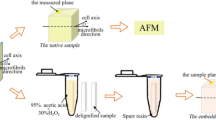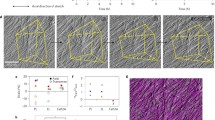Abstract
Atomic force microscopy (AFM), tapping mode atomic force microscopy (TM-AFM) and transmission electron microscopy (TEM) have been used to image the cell wall, ultrathin sections of whole cells and cellulose microfibrils prepared from the green alga Micrasterias denticulata. Measurements of the microfibril dimensions are in agreement with earlier observations carried out by electron microscopy. Images at the molecular level of the surface of the microfibrils were obtained with AFM and show regular periodicities along the microfibril axis that correspond to the fibre and glucose repeat distances of cellulose. Twisted regions visible at intervals along the microfibrils dried down onto substrates were noted to be right-handed in over 100 observations by TEM, AFM and TM-AFM.
Similar content being viewed by others
REFERENCES
Alexander, S., Hellemans, L., Marti, O., Schneir, J., Elings, V. and Hansma, P. K. (1989) An atomicresolution atomic force-microscope implemented using an optical lever. J. Appl. Phys. 65(1), 164–167.
Binnig, G., Quate, C. F. and Gerber, C. (1986) Atomic force microscope. Phys. Rev. Lett. 56(9), 930–933.
Blackwood, A. W. (1993) General preparation techniques for SEM. In Proceedures in electron microscopy (A. W. Robards and A. J. Wilson, eds). York, UK: John Wiley & Sons, Section 10:4, pp. 10–11.
Brown, R. M. Jr, Haigler, C. H., White, A. R. and Cooper, K. M. (1983) Biosynthesis and Degradation of Cellulose. J. Appl. Polym. Sci., Appl. Polym. Symp. 37, 33–78.
Engel, A. (1991) Biological applications of scanning probe microscopes. Annu. Rev. Biophys. Biophys. Chem. 20, 79–108.
Gardner, K. H. and Blackwell, J. (1974) The structure of native cellulose. Biopolymers 13, 1975–2001.
Giddings, T. H. Jr., Browler, D. L. and Staehelin, L. A. (1980) Visualization of particle complexes in the plasma membrane of Micrasterias denticulata associated with the formation of cellulose fibrils in primary and secondary walls. J. Cell Biology 84, 327–339.
Gray, D. G. (1996) Chirality in Cellulose and Cellulose-based Materials, Polymer Preprints (Div. Polymer Sci., American Chemical Society), 37(2), 485–486.
Hanley, S. J., Giasson, J., Revol, J.-F. and Gray, D. G. (1992) Atomic force microscopy of cellulose microfibrils; comparison with transmission electron microscopy. Polymer 33(21), 4639–4642.
Horton, O. and Amrein, M. eds (1993) STM and SFM in biology. San Diego, CA: Academic Press.
Kiermayer, O. and Sleyter, U. B. (1979) Hexagonally ordered `rosettes' of particles in the plasma membrane of Micrasterias denticulata breÂb. and their significance for microfibril formation and orientation. Protoplasma 101, 133–138.
Kim, N.-H., Herth, W., Vuong, R. and Chanzy, H. (1996) The cellulose system in the cell wall of Micrasterias. J. Structural Biol. 117, 185–203.
Kuutti, L., Peltonen, J., Pere, J. and Teleman, O. (1995) Identification and surface structure of crystalline cellulose studied by atomic force microscopy. J. Microsc. 178(1), 1–6.
Lal, R. and John, S. A. (1994) Biological applications of atomic force microscopy. Am. J. Physiol. 266 (Cell Physiol. 35), C1–C21.
Martin, Y., Williams, C. C. and Wickramasinghe, H. K. (1987) Atomic force microscope-force mapping and profiling on a sub 100 angstrom scale. J. Appl. Phys. 61(10), 4723–4729.
McClelland, G. M., Erlandsson, R. and Chiang, S. (1987) Atomic force microscopy: general principles and a new implementation in Review of progress in quantitative non-destructive evaluation. (D. O. Thompson and D. E. Chimenti, eds.) New York: Plenum Press. 1307.
McGuire, G. E., Swanson, M. L., Parikh, N. R., Simko, S., Weiss, P. S., Ferris, J. H., Nemanich, R. J., Chopra, D. R. and Chourasia, A. R. (1995) Surface characterisation. Anal. Chem. 67(12), 199R–220R.
Meyer, G. and Amer, N. M. (1988) Novel optical approach to atomic force microscopy. Appl. Phys. Lett. 53(12), 1045–1047.
Ohnesorge, F. and Binnig, G. (1993) True atomic resolution by atomic force microscopy through repulsive and attractive forces. Science 260, 1451–1456.
Putman, C. A. J., Van de Werf, K. O., De Grooth, B. G., Van Hulst, N. F. and Greeve, J. (1994) Tapping Mode Atomic Force Microscopy in Liquid. Appl. Phys. Lett. 64(18), 2454–2456.
Radmacher, M., Tillmann, R. W., Fritz, M. and Gaub, H. E. (1992) From molecules to cells-imaging soft samples with the AFM. Science 257, 1900–1905.
Revol, J.-F. (1990) Electron crystallography of radiation sensitive polymer crystals. In Electron Crystallography of Organic Molecules (J. R. Fryer and D. L. Dorset, eds). Dordrecht, Netherlands: Kluwer Academic Publishers. pp. 169–187.
Revol, J.-F., Bradford, H., Giasson, J., Marchessault, R. H. and Gray, D. G. (1992) Helicoidal selfordering of cellulose microfibrils in aqueous suspension. Int. J. Biol. Macromol. 14, 170–172.
Revol, J.-F., Godbout, L., Dong, X.-M., Gray, D. G., Chanzy, H. and Maret, G. (1994) Chiral nematic suspensions of cellulose crystallites; phase separation and magnetic field orientation. Liquid Crystals 16, 127–134.
Revol, J.-F. and Marchessault, R. H. (1993) In vitro chiral nematic ordering of chitin crystallites. Int. J. Biol. Macromol. 15, 329–335.
Ruben, G. C., Bokelman, G. H. and Krakow, W. (1989) Triple-stranded Left-hand Helical Cellulose Microfibril in Acetobacter xylinum and in Tobacco Primary Cell Wall. In Plant Cell Wall Polymers (N. G. Lewis and M. G. Paice, eds) Washington: ACS Symposium Series 399. pp. 278–298.
Waris, H. (1953) The significance for algae of chelating substances in the nutrient solutions. Physiologia Plantarum 6, 538–543.
Zhong, Q., Inniss, D., Kjoller, K. and Elings, V. B. (1993) Fractured polymer/silica fiber surface studied by Tapping Mode atomic force microscopy. Surf. Sci. 290(1-2), L668–L692.
Author information
Authors and Affiliations
Rights and permissions
About this article
Cite this article
HANLEY, S.J., REVOL, JF., GODBOUT, L. et al. Atomic force microscopy and transmission electron microscopy of cellulose from Micrasterias denticulata; evidence for a chiral helical microfibril twist. Cellulose 4, 209–220 (1997). https://doi.org/10.1023/A:1018483722417
Published:
Issue Date:
DOI: https://doi.org/10.1023/A:1018483722417




